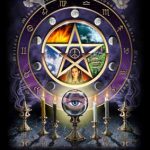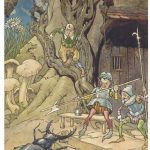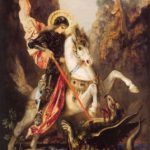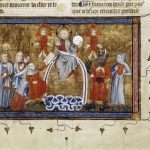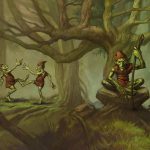The word Sabbat comes from the Greek work “sabatu”, which means “to rest”.
The Sabbats are representative of the turning of the wheel and each honor different phases in the life cycle of the Goddess and the God.

It is interesting to note that the eight Sabbats now known to modern Western pagans used to number only five: Bealtain, Midsummer, Lughnasadh, Samhain, and Yule.
Some commonly mentioned dates were February 1 (to some February 2), May 1 (Great Sabbat, Walpurgis Night), August 1 (lammas), November 1 (Halloween, commencing on October 30’s eve), Easter, and Christmas.
Other less frequently mentioned dates were Good Friday, January 1 (day of Jesus’ circumcision), June 23 (St. John’s Day), December 21 (St. Thomas), and Corpus Christi. and others.
The modern Sabbats that many Wiccans and NeoPagans now follow are: Imbolc (February 2), Ostara (Spring Equinox), Beltane (May 1), Litha (Summer Solstice), Lammas (August 1), Mabon (Autumn Equinox), Samhain (October 31) and Yule (Winter Solstice).
According to the testimonies of benandanti and similar European groups (see below), common dates for gatherings of witches are during the weeks of the Ember days, during the twelve days of Christmas or at Pentecost.
Samhain October 31st
Popularly known as Hallowe’en. Other names for this Sabbat include Shadowfest (Strega), Martinmas or Old Hallowmas (Scottish/Celtic).
The Feast of the Ancestors and Witches’ New Year. Trick-or-Treating evolved from Pagan “Souling,” when children representing ancestors collected food and blessed the houses they visited.
Samhain was the most awe-inspiring of the seasonal celebrations, feared by the ancient people because associated with the coming of winter, the cold and dark days and the scarcity of food. Not unexpectedly, Samhain was also the day to remember the souls of the departed.
Samhain occurred on November 1st and its eve was, of course, October 31st when the festivities actually commenced. (October 31 was then considered New Year’s Eve).
The pagan Celts believed that the two worlds, the physical world and the spirit world, drew closer on this date and that ghosts and apparitions of the dead could roam about the physical plane.
Samhain was a magical time, a time of the lighting of bonfires. Pagans customarily would put their fires out, then re-light them to represent the end of the year and the coming of the next.
With the coming of Christianity, which found it impossible to remove all the old beliefs from the populace, Samhain was transformed into All Saints’ Day, or as it was also called, All Hallows’ day (with hallow meaning holy or holy people).
The day before All Hallows’ Day was, of course, All Hallows’ Eve, or Halloween. The origins of modern Halloween are therefore based in ancient pagan Irish or Celtic beliefs.
Yule 22 December
also known as Yuletide which comes from a Nordic word meaning “wheel”.
The Winter Solstice is the shortest day of the year and, obviously, the longest night.
The waxing sun finally overcomes the waning sun and from this day on, the days will once again grow longer as we head toward spring and the rebirth of fertility once again
Imbolc 1 February
Also called Candlemas, Lupercus (Strega), Candelaria (Mexican Craft). It is the Feast of Returning Light which marks the banishing of the Winter Season and the welcoming of Spring.
In Ireland, Imbolc started out as a special day to honor the Great Mother Goddess Brigid, Goddess of holy wells, fire, healing, smithcraft, and poetry.
On this night, it is also said that the spirits of the dead walk among the living. In Ireland, these spirits are said to be seen at a crossroads.
Eostre 22 March
Also called Ostara, or the Spring (Vernal) named after the Anglo-Saxon Goddess of the Dawn and origin of the word “Easter.”
Equinox occurs when the night and day are of equal length and celebrate the Feast of Planting and Rebirth. In Wales, Ostara was known as Lady Day and signified the official return of the Goddess from her long winter hibernation.
Many of the myths associated with Ostara concern trips by deities into the mysterious underworld, and their struggle and eventual return to the land of the living.
Beltaine 1 May
Also called May Day, Beltane, Bealtaine (Celtic), Walpurgis (Teutonic), Rudemas (Mexican Craft), Festival of Tana (Strega) occurs on May 1st, falling opposite Samhain in the wheel of the year.
Beltane marks the start of summer, the beginning of the light half of the year and is a time for feasting, merry-making, celebration, and joy.
It is a time to look outward and forward and to prepare for the warm summer months ahead. It is also a time for love and union, representing the Divine Union of the Goddess and the God.
Litha 22 June
The Summer Solstice and the longest day of the year. Litha represents the Sun King in all his glory and power.
It is a celebration of passion and of ensuring the success of the crop. The Goddess is heavy with pregnancy and so is the earth.
Activities are mostly those to do with civilization and culture.
Lammas 1 August
Also known as Lughnasadh, Lugnasad (Celtic), Feast of Lugh,Loaf-mass, Cornucopia (Strega) or Thingtide (Teutonic). It represents the beginning of the harvest cycle.
In Western paganism, it is a grain festival which is sometimes called the Sabbat of the First Fruits.
Lammas or Lughnassadh honors the Celtic God Lugh, God of harvest, fire, light and sun who undergoes a shamanic sacrificial death and rebirth as a sheaf of grain at Lughnasadh, and/or the Barley God, who dies and is transformed into beer.
Mabon September 21st
Also known as Winter Finding (Teutonic), Mabon is the Autumn Equinox and is associated with the taking of corn and the completion of the harvest.
Druids honored the willow tree, a tree associated with death and rebirth, and cut their wands from its branches just before Mabon.
After this night of balance, darkness will once again overcome the light.

